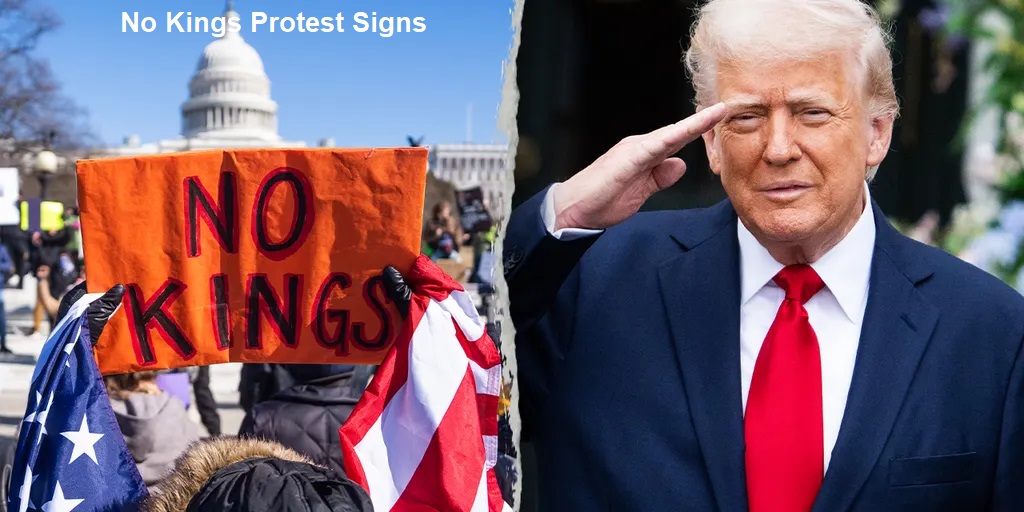No Kings Protest Signs: The Power of Words in Modern Dissent

No Kings Protest Signs have always been a reflection of the times — short, powerful, and filled with emotion. Among the recent waves of demonstrations around the world, one phrase has stood out for its simplicity and bold message: “No Kings.” The No Kings protest signs have become a symbol of modern rebellion against authority, privilege, and the concentration of power.
But what exactly does this phrase mean, and why has it captured the attention of so many activists and ordinary citizens alike? Let’s take a closer look at the roots, meanings, and growing impact of the “No Kings” slogan in today’s social and political movements.
The Origins of “No Kings” — A Return to Anti-Monarchy Ideals
The idea of rejecting kings and monarchies isn’t new. In fact, it goes back centuries. The phrase “No Kings” echoes early revolutionary sentiments, particularly those that emerged during the Enlightenment and the American Revolution. At its core, the slogan represents opposition to the idea that one person should rule over others simply by birthright.
In earlier history, “No Kings” was a cry for democracy and equality. People were tired of hereditary rulers who often lived in luxury while their citizens suffered. This phrase became symbolic of resistance — an insistence that power should belong to the people, not a throne.
Fast forward to today, and the same message has taken on new meaning. The “No Kings” slogan no longer applies solely to monarchies. Instead, it’s used against any form of authoritarianism or elite domination — whether in politics, business, or social hierarchies. Protesters now use No Kings protest signs to challenge modern “royalty” — billionaires, political dynasties, and systems that place certain people above others.
The Modern Context: From Palaces to Politics

In the 21st century, No Kings protest signs have made appearances at a wide range of events — from anti-monarchy demonstrations in the UK and Europe to broader political protests in the United States and Asia. The meaning has evolved beyond literal monarchs.
For many, “No Kings” is a metaphor for rejecting unchecked power. Whether it’s a government that doesn’t listen, a corporation exploiting workers, or a celebrity culture obsessed with worshipping the rich, the phrase has become a declaration of independence from blind obedience.
During protests related to economic inequality or political corruption, signs reading “No Kings, No Masters” often appear alongside “Power to the People” and “Equality for All.” These slogans share a common sentiment: leadership should serve, not rule. The No Kings phrase cuts straight to the heart of that philosophy — it rejects the very idea of power without accountability.
Symbolism Behind the No Kings Protest Signs
There’s something powerful about seeing a cardboard sign that simply reads “No Kings.” It’s short, but it carries centuries of meaning. The symbolism lies in its universality — anyone, from any background or country, can relate to the idea of not wanting to be ruled by someone who sees themselves as superior.
The No Kings protest signs also represent rebellion against hierarchy in general. In many modern contexts, the “king” isn’t a literal ruler — it might symbolize a corporation, a corrupt leader, or even societal systems that value wealth and status over fairness.
The phrase also appeals to younger generations, especially those active in social justice movements. It’s bold, minimalist, and meme-friendly. People use it not only on posters but also in digital art, graffiti, and social media graphics. It’s become a visual and verbal shorthand for self-empowerment — a rejection of domination and blind allegiance.
Why the Phrase Resonates Today
The reason “No Kings” has reemerged so strongly is because many people feel frustrated with systems that seem rigged in favor of a few. Whether it’s economic inequality, political corruption, or social injustice, the world often feels like it’s being run by “modern kings.”
The phrase gives voice to that frustration. It reminds people that democracy and equality require constant effort — that power must always be questioned. In an era of populism, celebrity politicians, and billionaire influence, No Kings protest signs feel like a breath of fresh air — a reminder that leadership is supposed to serve the people, not rule them.
Moreover, the phrase fits perfectly with the spirit of grassroots activism. It’s easy to write, easy to understand, and impossible to ignore. Three letters, two words, and a whole world of meaning.
Design and Creativity: What Makes “No Kings” Signs So Impactful
While the message is simple, the designs of No Kings protest signs vary widely — from handwritten cardboard pieces to artistically painted banners. Protesters often add their own creative flair, incorporating imagery like broken crowns, thrones on fire, or clenched fists to symbolize resistance.
Some choose minimalist black-and-white text, emphasizing the raw emotion behind the words. Others add humor, sarcasm, or pop culture references. The creativity behind these signs is part of what makes protest art so effective — it combines passion with visual storytelling.
In some rallies, entire walls or streets have been filled with “No Kings” artwork, turning public spaces into living galleries of dissent. These visuals are then shared online, amplifying the message far beyond the streets where the protest took place. It’s activism meeting artistry — a perfect blend of visual impact and ideological power.
The Global Reach of the Message
One of the most fascinating aspects of the No Kings protest movement is its universality. The phrase has appeared in different languages and countries, from the streets of London to protests in Bangkok, New York, and even parts of Africa.
Each region interprets the slogan in its own way. In places with constitutional monarchies, it’s taken literally — a call for the end of royal privilege. In republics or democratic nations, it’s metaphorical — aimed at political elites or corporate oligarchies. Yet the emotional foundation remains the same: opposition to oppression and inequality.
The global spread of “No Kings” shows how interconnected modern activism has become. A phrase that once belonged to revolutions centuries ago now resonates in a digital age, uniting people across borders in shared frustration and hope.
The Role of Social Media in Amplifying the Slogan
No modern protest can exist without the influence of social media, and No Kings protest signs are no exception. Platforms like Instagram, X (formerly Twitter), and TikTok have become digital megaphones for this slogan.
Protesters post photos of their signs, artists share digital illustrations, and activists turn the phrase into hashtags that spark discussion. The viral nature of the internet has helped “No Kings Protest Signs” reach people who may never attend a physical protest but still support the ideals behind it.
This online amplification turns a simple piece of cardboard into a movement. In many ways, digital protest is the modern version of holding a sign on the street — and “No Kings” fits perfectly within that ecosystem of quick, bold, shareable messages.
Criticism and Misinterpretation
Like most protest slogans, “No Kings Protest Signs” hasn’t escaped criticism. Some argue that it’s too vague or overly simplistic. Others believe that it unfairly targets traditions, especially in countries where monarchy still plays a symbolic or cultural role.
However, these criticisms often miss the point. The No Kings Protest Signs movement isn’t necessarily about attacking individuals or cultural traditions — it’s about challenging systems that elevate a select few above everyone else. It’s a metaphor for fairness, accountability, and the rejection of unearned privilege.
Even so, debates about the slogan’s meaning have helped keep it in the public eye. Controversy often fuels conversation, and in that sense, even criticism contributes to its ongoing relevance.
Why “No Kings” Is More Than Just a Protest Sign
At its core, “No Kings” is more than just a catchy phrase on cardboard. It’s a philosophy — a statement about equality and freedom. It reflects the desire for a world where people are judged by merit and character, not wealth, birthright, or social status.
It reminds us that democracy is not a fixed achievement but a continuous struggle. The No Kings protest signs are visual proof that people still care deeply about justice and fairness. They are a reminder that even in modern times, the fight against oppression — in all its forms — continues.
When someone holds up a “No Kings Protest Signs”, they’re not just protesting; they’re participating in a global conversation about what kind of society we want to live in.
Final Thoughts: The Enduring Power of “No Kings”
In an era where symbols matter more than ever, No Kings protest signs represent the enduring human desire for equality, dignity, and freedom from oppression. They connect today’s activists with centuries of rebellion — from revolutions that toppled monarchies to movements that challenge modern hierarchies.
The beauty of the slogan lies in its flexibility. It can be political, social, or even philosophical. It can challenge a literal monarchy or a metaphorical one. And while kings and empires may rise and fall, the idea behind “No Kings Protest Signs” remains timeless: no person, no system, and no institution should stand above the people.
In a world constantly testing the limits of democracy and fairness, that message couldn’t be more relevant. The cardboard signs might fade, but the cry of “No Kings Protest Signs” will continue echoing — as both a protest and a promise for a more equal future.


